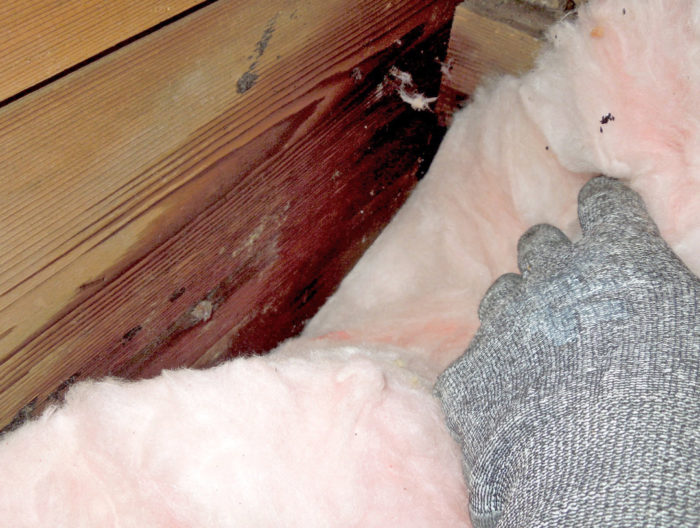
The dew point is a temperature. In my article on the psychrometric chart, I defined dew point as “the temperature at which moisture in the air begins to condense on hard surfaces.” Dew point can be measured or calculated for a specific point in time at a particular location, indoors or outdoors. No matter where it’s measured, the dew point can never be higher than the air temperature.
Here are a few other definitions for “dew point”:
- The dew point is the temperature to which air must be cooled to become saturated with water vapor.
- The dew point is the temperature at which the water vapor in a sample of air at constant barometric pressure condenses into liquid water at the same rate at which it evaporates.
- The dew point is the temperature the air needs to be cooled to (at constant pressure) in order to achieve a relative humidity (RH) of 100%.
Preventing moisture accumulation in sheathing
If you are a designer or builder who cares about the moisture performance of your walls, you’re likely to encounter the term “dew point” in any discussion of wintertime moisture accumulation in wall sheathing. If we know the dew point of a home’s interior air, and we know the temperature of the wall sheathing, we know what will happen if any of that warm interior air contacts the wall sheathing. For example, if the dew point of the interior air is 40°F, and the wall sheathing is at 32°F, we know that the sheathing is cold enough to accumulate moisture when the interior air comes in contact with the cold sheathing.
In this situation, we might say that “the sheathing is below the dew point of the interior air.”
So far, so good. For me, and for most builders, “dew…
Weekly Newsletter
Get building science and energy efficiency advice, plus special offers, in your inbox.

This article is only available to GBA Prime Members
Sign up for a free trial and get instant access to this article as well as GBA’s complete library of premium articles and construction details.
Start Free TrialAlready a member? Log in





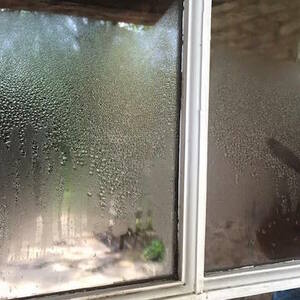
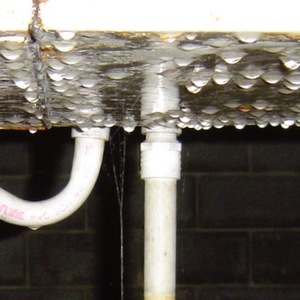
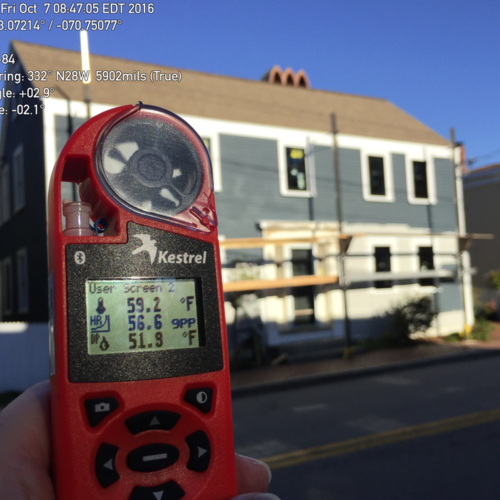
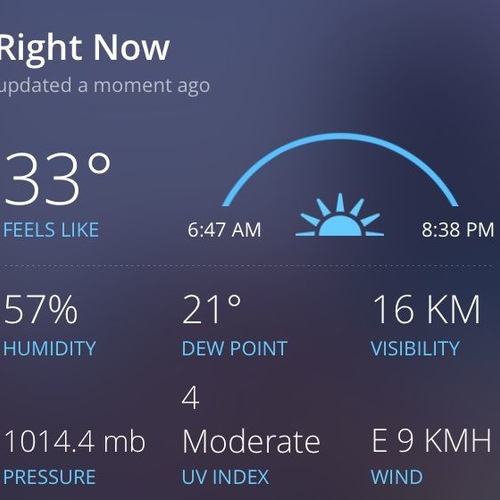






12 Comments
Smart phone apps...
For the smart phone crowd - there are several good apps for these kinds of calculations. My favorites are the PsychroApp from Munters and the Ultra-Aire app from Thermistor.
For what it's worth...
...dewpoints are always newsworthy in the Gulf Coast. They're a part of every TV weather report down there.
window operation and ventilation without a/c
How do the recommendations change for ventilation and window opening change if you have no a/c? Do you just decide based on temperature in that case? Or does it depend on the relationship between indoor and outdoor dew point?
Weather Underground 10-Day Charts are nice, too
As long as we're geeking out on weather data: I love Weather Underground's 10-Day charts, with dew point option turned on. Great for determining if it's going to be an AC day or a windows open day.
https://www.wunderground.com/
Response to Trevor Lambert (Comment #3)
Trevor,
Q. "How do the recommendations change for ventilation and window opening change if you have no AC? Do you just decide based on temperature in that case?"
A. Basically, yes. Also known as "common sense," or "whatever feels good," or "what Grandma used to do."
If you have cool nights and hot days, and no AC, it usually makes sense to open every window in the house at 8:00 p.m., and close all the windows when you wake up. But it's up to you.
dew point and temperature
An excellent and important article, as always! Thanks. But one clarification:
"No matter where it’s measured, the dew point is always less than the air temperature."
True except for the "always" part -- see "fogs" or "clouds," where the dew points *equal* air temperatures. Indeed, these exceptions are implicit in the "other definitions for dew point" that you list. But fogs and clouds aren't really relevant to building design. Hopefully.
In our universe and thanks to the latent heat of evaporation, the dew point can never by *more* than the air temperature -- just like a glass of ice water can never be colder than 0 degrees C (owing to the latent heat of fusion). Water is AMAZING stuff -- we should all get to know it better!
Pickin' nits, are we, Rob? :-)
In the right environmental chamber it's possible to hyper-chill clean air to a number of degrees below the dew point without creating fog, but who cares? ;-)
Fogs and clouds are relevant to building design in temperate coastal micro-zones and rain forests, where the capacity for drying toward the exterior is severely diminished. But most of us don't live there.
Overnight low temperature and dew point
There is another aspect of dew point I find intriguing. I’ve looked at the overnight low temperature and compared that to the average dewpoint temperature for the following day here in Champaign, Illinois. They show excellent agreement and correspond almost exactly 1-to-1. This makes sense. The overnight low causes air humidity to be deposited on cold surfaces down to the dewpoint. Other factors are at work, but the correspondence is remarkable.
Maybe more remarkable is that the New York Times just did a piece on how overnight low temperatures are climbing with warming — more than average temperature, and certainly more than high temperature for the day. They focused on the discomforts this creates, and missed the humidity connection entirely. Then the next day they did a piece on increasing severity of storms. Duh.
Climate change and dew point
Thanks, Bill. So rising overnight low temperatures (if they are indeed occurring) will bring an increase in muggy, humid weather. Another aspect of climate change to look forward to...
Response to Rob Rowan (Comment #6)
Rob,
Thanks for your comment. Nothing wrong with picking nits. I have changed "is always lower than" to "can never be higher than."
Dew points are rising
Yes, we can expect rising dewpoints with global warming. The thought isn’t new with me, I’ve read it several places. Some of the NOAA work on increasing severity of storms was done by a high school classmate of mine, Rob Tuleya, and if I recall correctly he attributed it in part to rising overnight lows.
Also, this discussion seems to have the white space above the saturation line on a psych chart as a no-man’s-land. In fact, supersaturation is a thrilling area of study, starting with Nagaya’s work on ice and snow, done during WWII. He showed that higher degrees of supersaturation at the instant a snowflake is nucleated (cleaner air especially) lead to greater dendritic beauty.
Mostly no-man's-land with at least one tip of the hat@ Bill Rose
>"...supersaturation is a thrilling area of study, starting with Nagaya’s work on ice and snow, done during WWII..
Previously in #7 I pointed out:
"...it's possible to hyper-chill clean air to a number of degrees below the dew point without creating fog..."
Instances of that happening at ground level in populated area with lots of buildings around are rare enough to not really matter relative to building science/ building design purposes, but it is pretty cool stuff (in all senses of the term.)
High altitude snow sometimes/often shows characteristics of having been formed in hyper chilled super saturated air at temperatures below the dew point. But that air is a lot cleaner than air typically found at ground level outside of arctic/antarctic zones- it's not going to be happening at MY house.
Log in or become a member to post a comment.
Sign up Log in